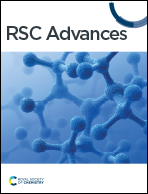Performance degradation study of NiCo2O4-based asymmetric supercapacitors
Abstract
The performance of NiCo2O4//GO asymmetric supercapacitors was found to decline after many tests. It was found that the performance of the GO electrode was almost unchanged, while the performance of the NiCo2O4 electrode declined rapidly. Therefore, porous spherical NiCo2O4 nanoparticles were synthesized via a simple hydrothermal method. A NiCo2O4//GO asymmetric supercapacitor was made, which can be charged and discharged 3000 times in the current density of 10 A g−1. The surface morphology, crystal structure and elemental composition were characterized by X-ray diffraction analysis, scanning electron microscopy and X-ray photoelectron spectroscopy. By comparing the surface morphology, crystal structure and elemental composition of the NiCo2O4 electrode before and after the cycle, it was found that the performance of NiCo2O4 electrode declines rapidly after the cycle due to the formation of new substances and the destruction of the crystal structure of NiCo2O4 electrode. Therefore, maintaining the stability of the crystal structure of the electrode material is an important means to ensure the stability of the performance of the supercapacitor. It provides a meaningful strategy for studying the degradation of supercapacitor electrode materials.



 Please wait while we load your content...
Please wait while we load your content...